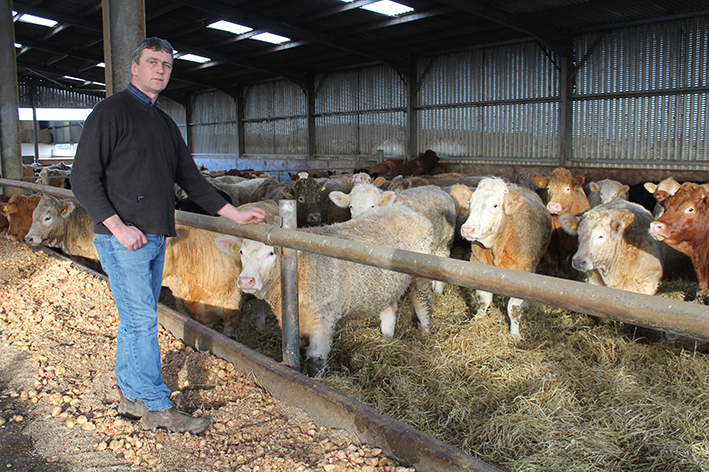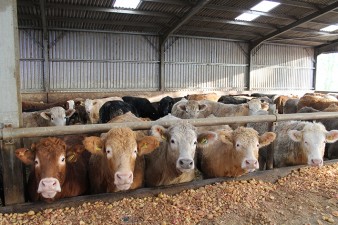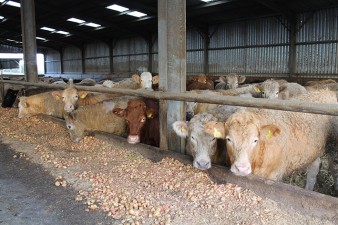 Alan Meston, Chapelton, Stonehaven
Alan Meston, Chapelton, Stonehaven
Spinning plates comes to mind when you visit at the finishing operation run by Alan Meston at Chapelton Farm, Stonehaven just south of Aberdeen where last year, he finished 2600 bullocks and 200 heifers including 1400 head of Charolais.
Despite the volumes that go through the farm, Alan has the figures at his fingertips, quoting the 2016 averages as 224 kg weight gain in 168 days, with an average of 70 days grazing (allowing 1kg gain/day on grass). The aim is for cattle to gain 160kgs in 100 days on his finishing ration.
“Five to six years ago, it was all short term finishing and I would have had 8-900 cattle on the farm at any one time, kept for around 100 days to put on 140kgs.” says Mr Meston.
“With the change in system and now keeping a mix of growing and finishing cattle, the most I have put through in a 12 month period is 2800, keeping around 1200-1400 on the farm at any one time.
I graze 700-800, mainly Charolais because I think they do best at grass. You can get Charolais finishing at 16-20 months – this is where the breed has the big advantage. You want weight for age, nothing will beat them.”
Mr Meston purchased the farm from his late father back in 2002 and has pushed numbers since then, at one stage taking them from 500 up to 1400 over a two year period. A new steading with two sheds was built in 2009 and since then a further shed added and some have been extended. Two additional buildings are rented at a neighbouring farm.
Chapelton itself has 310 acres with a further 115 acres of rented seasonal grazing rented. A total of 260 acres of grass isare grazed and Alan realises the significant feeding value of grass, keeping it up to four years then reseeding.
“Buying growing cattle lets me spread my risk. It lets me better utilise the grass and make the best use of my intensive finishing.” he says.
Cattle are purchased from January to October with an average of 1200 on the farm at any one time, peaking at 1450. Alan purchases at Stirling, Thainstone, Huntly and on farm, particularly Charolais in larger batches. He also buys younger animals around 10-12 months, to grow them on grass then finish inside in July-August.
 He rarely buys into November or December because of the increased risk from disease, particularly pneumonia which coupled with poor weather can have a great impact on performance.
He rarely buys into November or December because of the increased risk from disease, particularly pneumonia which coupled with poor weather can have a great impact on performance.
He starts buying for grass in March, looking for leaner cattle and those which will give the highest feed conversion – and that will make money.
“I’m not buying the top cattle at the ringside, I’m buying the second part, good commercial cattle.
The Charolais has great potential – some breeders take them too far, perhaps to get a bit more money for them but it leaves little for the finisher to gain. It’s better to sell them in leaner condition.”
“You also have to look at what it costs the breeder to get them heavier, if they are too well fed, they don’t do so well. They lose condition when they go to grass, they just melt.” he added
“I’m trying to be on top of the market and have a good idea of what happens and there is a cycle of around six months. I’m seeing gradual changes in the suckler market, seeing cattle being sold at lighter weights – the finisher needs to get their chance to do their bit.”
Cattle are regularly weighed on and off grass, on and off finishing rations and then prior to slaughter allowing Mr Meston to monitor growth alongside recording feed intakes.
Younger cattle up to a 15 month limit are put to grass, with the biggest animals on grass for six to eight weeks. They are rotated on the grass fields, with them moving closer to the finishing sheds as they get closer to weight.
All cattle are weighed on arrival and treated routinely for IBR, Blackleg, worms and fluke.
“The regime at Chapelton depends upon the age and size – it’s a very flexible system which works around the market.” he says Alan.
Cattle might only be on grass for a few weeks, moving to the starter ration for two weeks. Nutritional advice and inputs are provided by Harbro and David Mackenzie, Harbro is a regular visitor to Chapelton to advise on diet and performance.
Cattle will be grown at grass supplemented with Energyze Cattle or inside on a silage/wholecrop/draff mix before moving on to the finishing ration, transitioning over a 14 day period.
With the reduced weight limits, Mr Meston doesn’t want them going over 700kg and incurring penalties so at 500kg, they go on to the finishing ration.
The finishing ration includes barley, biscuit meal, draff, potle ale syrup, dark grains and potatoes and is supplemented with Harbro Grampian Finisher mineral with Yea-Sacc and Rumitech.
Alan says the Rumitech helps with weight gain, “It helps keep them leaner and in the better grades.”
Such is the volume of feed consumed that two loads of washed potatoes are used every week. Cattle always have fresh feed in front of them every day with any remaining feed from the previous day removed.
“We let the troughs go empty for an hour every day, it keeps the edge on their appetite and, it maximises intakes and weight gain
Charolais bullocks spent an average 168 days on farm. “I buy to get as much weight on as possible in as short a time.”
“You need to grow them to a certain level, and you need the frame on them to finish. They cost a bit more to buy but you will get them to the better end of the prices more quickly.”
All of the kill from Chapelton achieves R or U grades – over the year, 50-60% were U grades with 10p premium on a –U and 20p on a +U which was achieved by 5%.
Cattle are kept in straw-bedded pens of 90-100 head drawn over a three week period with 40 away for slaughter every week but in November, they dispatched had 120 per week for three weeks, nearly all Charolais at 16-20 months for the Christmas market.
“The weight limit at McIntosh Donald is capped at 420kgs for bullocks, with severe penalties for cattle over the limit so I keep them within specification
Charolais bullocks averaged 385kg for the year with heifers coming in at 345 kg average, I have very few which are overweight.”
Following in the footsteps of his father also a finisher, Mr Meston bought his first cattle at the age of 13 at Thainstone’s forerunners, Kittybrewster and Belmont marts in Aberdeen. He is helped at home by wife Lesley who looks after the accounts, son Stewart, aged 19 along with a part-time man who works two days a week.
Stewart is now learning the ropes. He has been buying cattle for the last 15 months, some for his father and some for himself.
 There’s an air of calm at Chapelton, cattle are quiet and contented. It’s an efficient operation too, where the 1200-1400 head of cattle can be fed in two hours, leaving plenty time for cattle to be sorted.
There’s an air of calm at Chapelton, cattle are quiet and contented. It’s an efficient operation too, where the 1200-1400 head of cattle can be fed in two hours, leaving plenty time for cattle to be sorted.
“If they are poorer performers, I am pretty ruthless so they’ll go for kill: we are looking at them being on the finishing ration for 100 days but when they have been on it for 120 days, it is time for them to go.
Now that I am adding more growing cattle and buying them younger, I’m producing more kgs of beef on farm and, keeping the weight gain up for a longer period. Over the last four years, the average annual weight gain has increased 0.05kg/day year on year from 1.2 up to 1.4kg/day.
Mr Meston points out that “You can get a 20p premium with native breeds (Aberdeen Angus) but, you can get the same premium with good continental grades.
We are docked 5p/kg for 4H fat cover. Charolais definitely gives the weight, getting up close to maximum weight at the 4L stage which is what the slaughterhouse wants.
In essence, the Charolais gives the weight we want with the conformation that we want in the shortest time.”
Categories: Commercial, News
Northern Ireland Sweep the Board at the Charolais Youth National Stockjudging Final » « Results from the Charolais Bull Requirements Survey